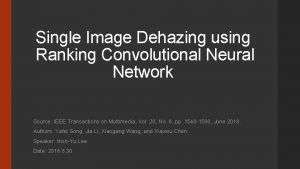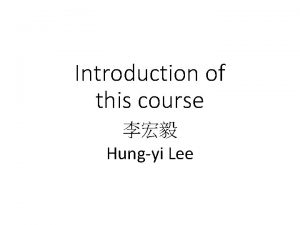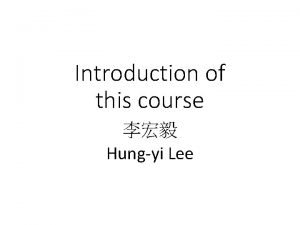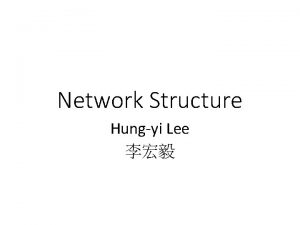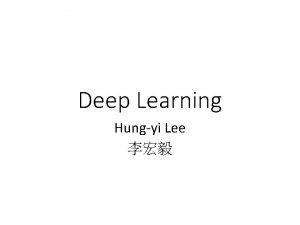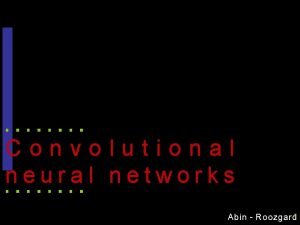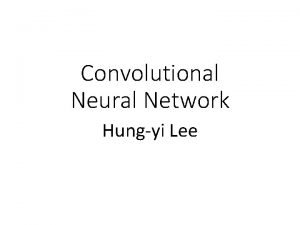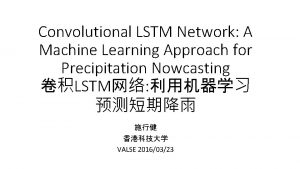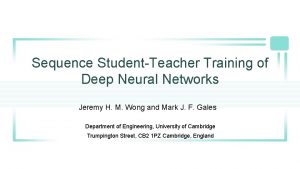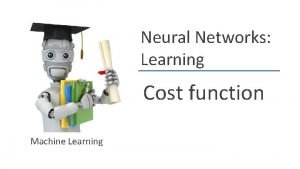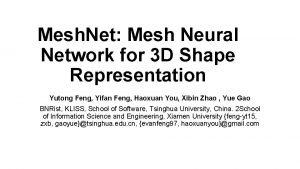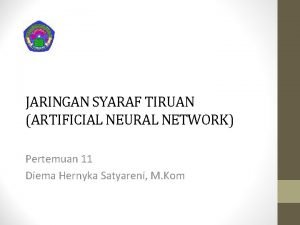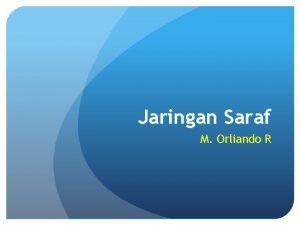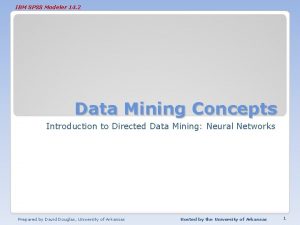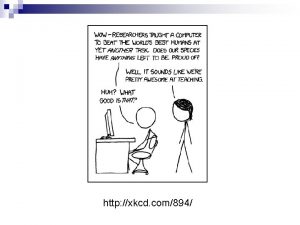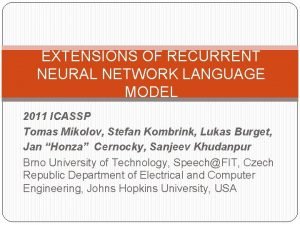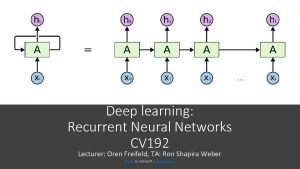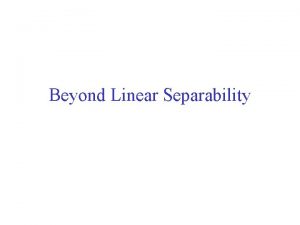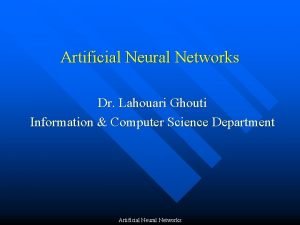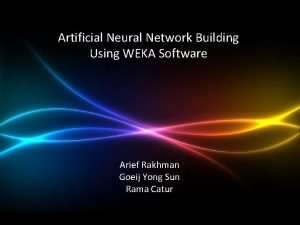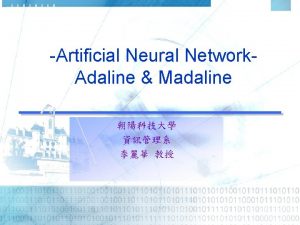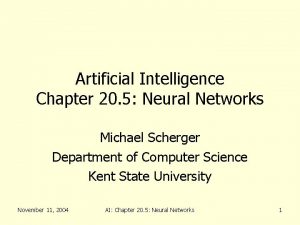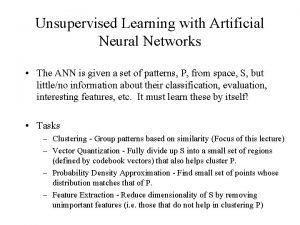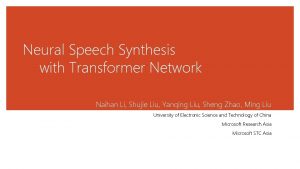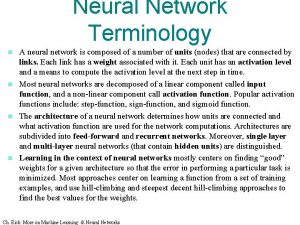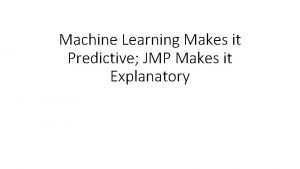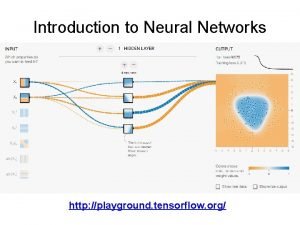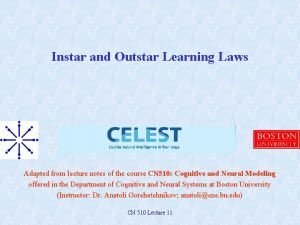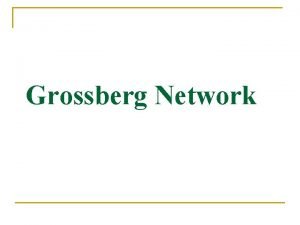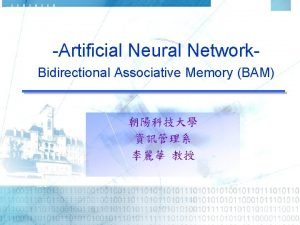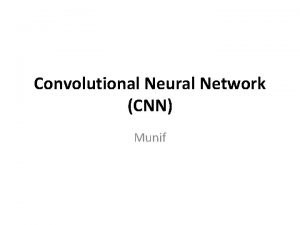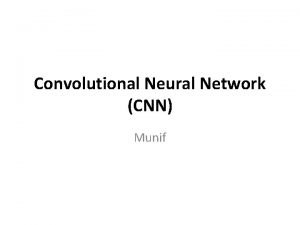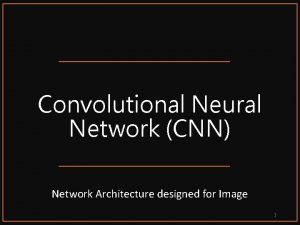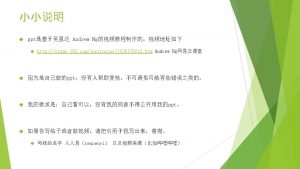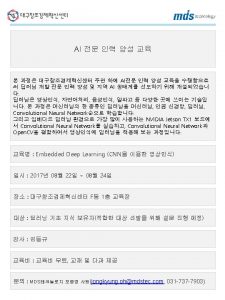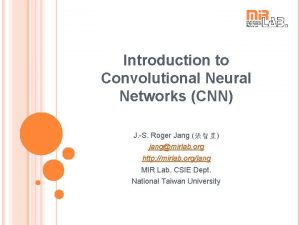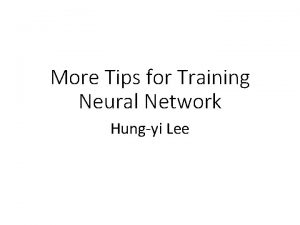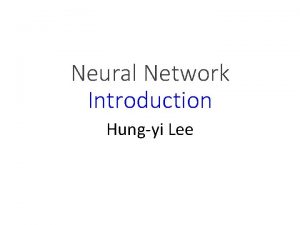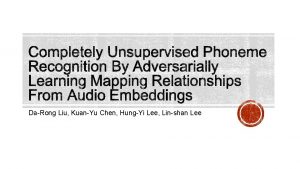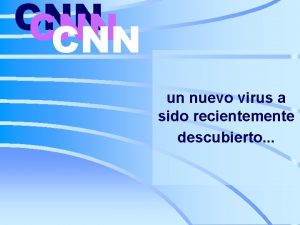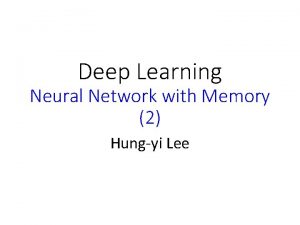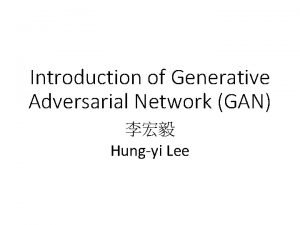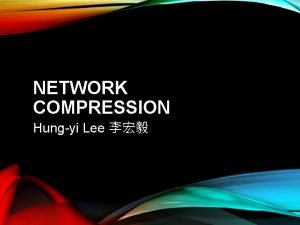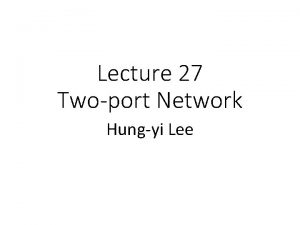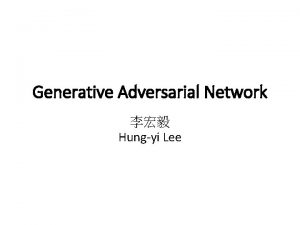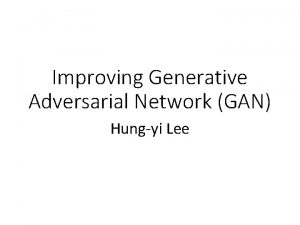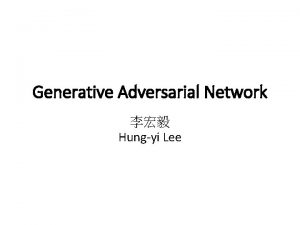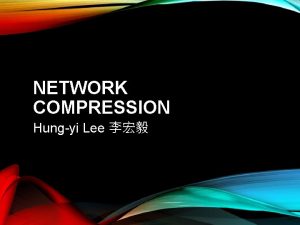Convolutional Neural Network Hungyi Lee Why CNN for

![Why CNN for Image? [Zeiler, M. D. , ECCV 2014] …… …… …… The Why CNN for Image? [Zeiler, M. D. , ECCV 2014] …… …… …… The](https://slidetodoc.com/presentation_image_h/d1d310b86b54346bfe036c0f38d9d6fd/image-2.jpg)











































- Slides: 45

Convolutional Neural Network Hung-yi Lee
![Why CNN for Image Zeiler M D ECCV 2014 The Why CNN for Image? [Zeiler, M. D. , ECCV 2014] …… …… …… The](https://slidetodoc.com/presentation_image_h/d1d310b86b54346bfe036c0f38d9d6fd/image-2.jpg)
Why CNN for Image? [Zeiler, M. D. , ECCV 2014] …… …… …… The most basic classifiers …… Represented as pixels …… Use 1 st layer as module to build classifiers Use 2 nd layer as module …… Can the network be simplified by considering the properties of images?

Why CNN for Image • Some patterns are much smaller than the whole image A neuron does not have to see the whole image to discover the pattern. Connecting to small region with less parameters “beak” detector

Why CNN for Image • The same patterns appear in different regions. “upper-left beak” detector Do almost the same thing They can use the same set of parameters. “middle beak” detector

Why CNN for Image • Subsampling the pixels will not change the object bird subsampling We can subsample the pixels to make image smaller Less parameters for the network to process the image

The whole CNN cat dog …… Convolution Max Pooling Fully Connected Feedforward network Convolution Max Pooling Flatten Can repeat many times

The whole CNN Property 1 Ø Some patterns are much smaller than the whole image Property 2 Ø The same patterns appear in different regions. Property 3 Convolution Max Pooling Convolution Ø Subsampling the pixels will not change the object Flatten Max Pooling Can repeat many times

The whole CNN cat dog …… Convolution Max Pooling Fully Connected Feedforward network Convolution Max Pooling Flatten Can repeat many times

CNN – Convolution 1 0 0 1 0 0 0 1 0 1 1 0 0 0 1 1 0 0 1 -1 -1 -1 1 Filter 1 -1 -1 -1 Filter 2 Matrix 1 1 1 -1 -1 -1 Matrix …… 6 x 6 image Those are the network parameters to be learned. Each filter detects a small Property 1 pattern (3 x 3).

1 -1 -1 -1 1 CNN – Convolution stride=1 1 0 0 1 0 0 0 1 0 1 1 0 0 0 1 1 0 0 6 x 6 image 3 -1 Filter 1

1 -1 -1 -1 1 CNN – Convolution If stride=2 1 0 0 1 0 0 0 1 0 1 1 0 0 0 1 1 0 0 6 x 6 image 3 Filter 1 -3 We set stride=1 below

CNN – Convolution stride=1 1 -1 -1 -1 1 Filter 1 1 0 0 1 0 0 0 1 0 1 1 0 0 0 3 -1 -3 1 0 -3 0 0 1 1 0 0 -3 -3 0 1 3 -2 -2 -1 6 x 6 image Property 2

-1 -1 -1 CNN – Convolution stride=1 1 0 0 1 0 0 0 1 0 1 1 0 0 0 1 1 0 0 6 x 6 image 1 1 1 -1 -1 -1 Filter 2 Do the same process for every filter 3 -1 -1 -1 -3 -1 1 -1 0 -2 -3 1 -3 -1 Feature -3 Map 0 -1 -2 -2 0 -2 -4 4 x 4 image 1 1 -1 3

CNN – Colorful image -1 -1 11 -1 -1 -1 -1 -1 111 -1 -1 -1 Filter 2 -1 1 -1 Filter 1 -1 -1 -1 11 -1 -1 -1 -1 1 1 0 0 0 0 1 0 11 00 00 01 00 1 0 0 00 11 01 00 10 0 1 1 0 0 1 00 00 10 11 00 0 11 00 00 01 10 0 0 1 0 0 00 11 00 01 10 0 1 0

Convolution v. s. Fully Connected 1 0 0 1 1 -1 -1 -1 0 1 0 -1 1 -1 0 0 1 1 0 0 -1 -1 1 0 0 0 1 0 1 0 convolution image 0 0 0 1 0 0 0 1 1 0 0 0 1 0 0 0 1 0 …… Fullyconnected 1

1 -1 -1 Filter 1 -1 -1 -1 1 0 0 0 1 0 0 1 1 0 0 6 x 6 image Less parameters! 7 0 : 8 1 : 9 0 : 0 10: … 0 1 0 0 3 … 1 0 0 1 1 1 : 2 0 : 3 0 : 4 0 : 13 0 : 0 14 : 15: 1 16: 1 … Only connect to 9 input, not fully connected

1 -1 -1 -1 1 Filter 1 0 0 0 1 0 1 1 0 0 0 1 1 0 0 6 x 6 image Less parameters! 13 0 : 0 14 : 15: 1 16: 1 … Even less parameters! 7 0 : 8 1 : 9 0 : 0 10: -1 … 0 1 0 0 3 … 1 0 0 1 1 1 : 2 0 : 3 0 : 4 0 : Shared weights

The whole CNN cat dog …… Convolution Max Pooling Fully Connected Feedforward network Convolution Max Pooling Flatten Can repeat many times

CNN – Max Pooling 1 -1 -1 -1 Filter 1 1 -1 -1 -1 Filter 2 3 -1 -1 -1 -3 1 0 -3 -1 -1 -2 1 -3 -3 0 1 -1 -1 -2 1 3 -2 -2 -1 -1 0 -4 3

CNN – Max Pooling 1 0 0 1 0 0 0 1 0 1 1 0 0 0 1 1 0 0 6 x 6 image New image but smaller Conv Max Pooling 3 -1 0 3 1 0 1 3 2 x 2 image Each filter is a channel

The whole CNN 3 -1 0 3 1 0 1 3 Convolution Max Pooling A new image Smaller than the original image The number of the channel is the number of filters Convolution Max Pooling Can repeat many times

The whole CNN cat dog …… Convolution Max Pooling A new image Fully Connected Feedforward network Convolution Max Pooling Flatten A new image

3 Flatten 0 1 3 -1 0 3 1 0 1 3 3 Flatten -1 1 0 3 Fully Connected Feedforward network

Only modified the network structure and input format (vector -> 3 -D tensor) CNN in Keras input 1 -1 -1 -1 1 -1 1 Convolution -1 -1 -1 …… There are 25 3 x 3 filters. Input_shape = ( 1 , 28 ) 1: black/weight, 3: RGB 28 x 28 pixels 3 -1 -3 1 3 Max Pooling Convolution Max Pooling

CNN in Keras Only modified the network structure and input format (vector -> 3 -D tensor) 1 x 28 input Convolution How many parameters for each filter? 9 25 x 26 Max Pooling 25 x 13 How many parameters 225 for each filter? Convolution 50 x 11 Max Pooling 50 x 5

CNN in Keras Only modified the network structure and input format (vector -> 3 -D tensor) input 1 x 28 output Convolution 25 x 26 Fully Connected Feedforward network Max Pooling 25 x 13 Convolution 50 x 11 1250 Flatten Max Pooling 50 x 5

Live Demo

What does CNN learn? The output of the k-th filter is a 11 x 11 matrix. Degree of the activation of the k-th filter: x input 25 3 x 3 Convolution filters (gradient ascent) 11 11 Max Pooling -1 -3 1 …… -3 …… -1 3 -2 …… …… …… -1 …… 3 50 3 x 3 Convolution filters 50 x 11 Max Pooling

What does CNN learn? The output of the k-th filter is a 11 x 11 matrix. Degree of the activation of the k-th filter: input 25 3 x 3 Convolution filters (gradient ascent) Max Pooling 50 3 x 3 Convolution filters 50 x 11 Max Pooling For each filter

What does CNN learn? Find an image maximizing the output of neuron: input Convolution Max Pooling flatten Each figure corresponds to a neuron

What does CNN learn? input Can we see digits? 0 1 2 Convolution Max Pooling 3 4 5 flatten 6 7 8 Deep Neural Networks are Easily Fooled https: //www. youtube. com/watch? v=M 2 Ieb. CN 9 Ht 4

What does CNN learn? Over all pixel values 0 1 2 3 4 5 6 7 8

CNN Deep Dream Modify image • Given a photo, machine adds what it sees …… CNN exaggerates what it sees http: //deepdreamgenerator. com/

Deep Dream • Given a photo, machine adds what it sees …… http: //deepdreamgenerator. com/

Deep Style • Given a photo, make its style like famous paintings https: //dreamscopeapp. com/

Deep Style • Given a photo, make its style like famous paintings https: //dreamscopeapp. com/

Deep Style A Neural Algorithm of Artistic Style CNN content style https: //arxiv. org/abs/1508. 06576 CNN ?

More Application: Playing Go Network 19 x 19 matrix 19(image) x 19 vector Black: 1 white: -1 none: 0 Next move (19 x 19 positions) 19 x 19 vector Fully-connected feedforward network can be used But CNN performs much better.

More Application: Playing Go Training: record of 黑: 5之五 previous plays 白: 天元 黑: 五之5 … CNN Target: “天元” = 1 else = 0 CNN Target: “五之 5” = 1 else = 0

Why CNN for playing Go? • Some patterns are much smaller than the whole image Alpha Go uses 5 x 5 for first layer • The same patterns appear in different regions.

Why CNN for playing Go? • Subsampling the pixels will not change the object Max Pooling How to explain this? ? ? Alpha Go does not use Max Pooling ……

More Application: Speech Frequency CNN The filters move in the frequency direction. Image Time Spectrogram

More Application: Text ? Source of image: http: //citeseerx. ist. psu. edu/viewdoc/download? doi =10. 1. 1. 703. 6858&rep=rep 1&type=pdf

To learn more …… • The methods of visualization in these slides • https: //blog. keras. io/how-convolutional-neuralnetworks-see-the-world. html • More about visualization • http: //cs 231 n. github. io/understanding-cnn/ • Very cool CNN visualization toolkit • http: //yosinski. com/deepvis • http: //scs. ryerson. ca/~aharley/vis/conv/ • The 9 Deep Learning Papers You Need To Know About • https: //adeshpande 3. github. io/ The-9 -Deep-Learning-Papers-You-Need-To-Know. About. html

To learn more …… • How to let machine draw an image • Pixel. RNN • https: //arxiv. org/abs/1601. 06759 • Variation Autoencoder (VAE) • https: //arxiv. org/abs/1312. 6114 • Generative Adversarial Network (GAN) • http: //arxiv. org/abs/1406. 2661
 Convolutional neural network
Convolutional neural network Convolutional neural network alternatives
Convolutional neural network alternatives Feature map in cnn
Feature map in cnn Hungyi
Hungyi Hung yi lee
Hung yi lee Hung-yi lee
Hung-yi lee Hungyi lee
Hungyi lee Hungyi
Hungyi Visualizing and understanding convolutional networks
Visualizing and understanding convolutional networks Convolutional neural networks for visual recognition
Convolutional neural networks for visual recognition Leon gatys
Leon gatys Sparse convolutional neural networks
Sparse convolutional neural networks Netinsights
Netinsights Convolutional neural networks
Convolutional neural networks Convolutional neural networks
Convolutional neural networks Andreas carlsson bye bye bye
Andreas carlsson bye bye bye Is cnn a feedforward network
Is cnn a feedforward network Fc-lstm
Fc-lstm Merzenich et al (1984) ib psychology
Merzenich et al (1984) ib psychology Least mean square algorithm in neural network
Least mean square algorithm in neural network Student teacher deep learning
Student teacher deep learning Backpropagation andrew ng
Backpropagation andrew ng Threshold logic unit
Threshold logic unit Meshnet: mesh neural network for 3d shape representation
Meshnet: mesh neural network for 3d shape representation Pengertian artificial neural network
Pengertian artificial neural network Neural network in r
Neural network in r Matlab u-net
Matlab u-net Spss neural network
Spss neural network Xkcd neural network
Xkcd neural network Extensions of recurrent neural network language model
Extensions of recurrent neural network language model Draw: a recurrent neural network for image generation
Draw: a recurrent neural network for image generation Limitations of perceptron:
Limitations of perceptron: Artificial neural network in data mining
Artificial neural network in data mining Least mean square algorithm in neural network
Least mean square algorithm in neural network Weka neural network
Weka neural network Adaline neural network
Adaline neural network Decision boundary of neural network
Decision boundary of neural network Maxnet neural network
Maxnet neural network Reported speech transformer
Reported speech transformer Neural network terminology
Neural network terminology Jmp neural network
Jmp neural network Tensorflow.org
Tensorflow.org Instar and outstar in neural network
Instar and outstar in neural network Grossberg neural network
Grossberg neural network Neural network in data mining
Neural network in data mining Auto associative memory
Auto associative memory


